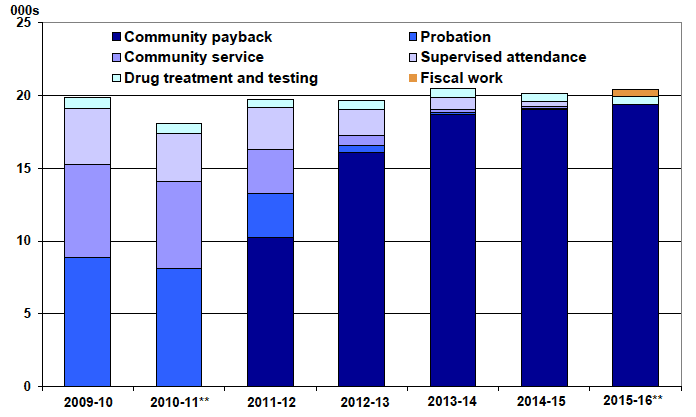Criminal justice social work statistics in Scotland: 2015-2016
National-level information on criminal justice social work activity in Scotland, including data on criminal justice social work services and social work orders.
This document is part of a collection
1 Introduction
1.1 This publication presents national-level information on criminal justice social work activity in Scotland. The report includes data on criminal justice social work services and social work orders, as well as characteristics of the individuals involved.
1.2 The number of social work orders issued has been fairly stable over the past seven years with numbers generally around the 20,000 mark. The most recent figures show 20,400 orders issued in 2015-16 ( Chart 1 and Table 2).
Chart 1 Social work orders issued: 2009-10 to
2015-16

** Figures for 2010-11 exclude around 300 community payback orders and for 2015-16 exclude around 200 legacy orders as details of these were not collected from local authorities in those years (see Annex A).
Highlights
- The number of criminal justice social work reports submitted to the courts has shown an overall downward trend over the past six years. The most recent figure for 2015-16 is a drop of 3 per cent on the previous year, from 30,800 to 29,800 (including supplementary reports), and has dropped by over a quarter since 2009‑10, broadly reflecting changes in court volumes ( Table 1).
- The number of social work orders issued has been fairly stable over the past seven years with numbers generally around the 20,000 mark, the most recent figures showing a total of 20,400 in 2015-16 ( Table 2).
- Over three-quarters (76 per cent) of total social work orders commencing in 2015-16 included an element of unpaid work or other activity ( Table 2 and Table 11).
- There were 19,400 community payback orders commenced in 2015-16, around 95 per cent of social work orders imposed in that year ( Table 2). Most community payback orders included a requirement for unpaid work or other activity (78 per cent), and 51 per cent included offender supervision ( Table 11).
- The average number of requirements in a community payback order has fallen each year from 1.82 in 2011-12 to 1.45 in 2015-16. The prevalence of all requirements has fallen over this period with the exception of unpaid work or other activity ( Chart 4).
- Sixty-two per cent of people given an offender supervision requirement of up to 6 months were aged 30 or under, compared with only 38 per cent for those given the maximum of 36 months ( Chart 5).
- Sixty eight per cent of community payback order terminations resulted in completion/ discharge in 2015-16. This represents a drop from the 72 per cent recorded in 2013-14 but is consistent with levels in the high 60s in all other years back to 2011-12 ( Table 2).
- Successful completion rates for community payback orders were highest for those aged over 40 (78 per cent) and those employed/self-employed (81 per cent) ( Chart 7).
- There were 520 drug treatment and testing orders commenced in 2015-16, the lowest ever total since this was first collected, and almost 30 per cent lower than in 2009-10 ( Table 2).
- Around 510 fiscal work orders commenced in 2015-16, just over half (52 per cent) of which were for people aged 25 or under ( Table 31).
- The number of statutory custody- and community-based throughcare cases commenced was 2,000 in 2015-16, around the same as in earlier years ( Tables 1, 32 and 33).
Contact
There is a problem
Thanks for your feedback